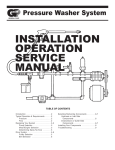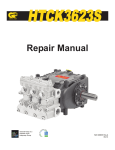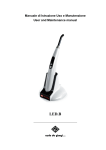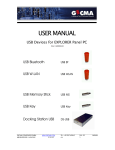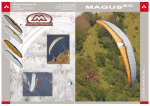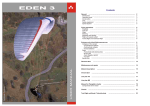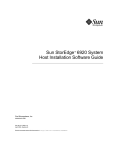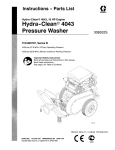Download INSTALLATION OPERATION SERVICE MANUAL
Transcript
Pressure Washer System INSTALLATION OPERATION SERVICE MANUAL TABLE OF CONTENTS Introduction ..........................................................2 Typical Operation & Requirements .......................2 Pressure .........................................................2 Flow................................................................2 Designing Your System ...................................3 - 5 Pump Selection ..............................................3 Motor/Engine Selection ..................................3 Determining Spray Tip Size............................5 Drive System ...................................................5 - 6 Pulley Selection..............................................5 Belt Selection .................................................6 Selecting Remaining Components . . . . . . 6 - 7 Upstream or Inlet Side Components . . . . . . . . . . . . . . . . . . . 6 Downstream or Outlet Side Components . . . . . . . . . . . . . . . . 6 - 7 Installing Your Components . . . . . . . . . . . 7 - 8 Troubleshooting . . . . . . . . . . . . . . . . . . . . . . . 9 Servicing Your Pump. . . . . . . . . . . . . . . 10 - 11 Valve Assemblies. . . . . . . . . . . . . . . . . . 10 Removing Manifold Head . . . . . . . . . . . 10 Replacing Plungers . . . . . . . . . . . . . . . . 11 Replacing Packings . . . . . . . . . . . . . . . . 11 INTRODUCTION or closed, therefore a device is needed to control the direction of flow, either allowing the flow to go through the open spray gun, or redirecting (by-passing) the flow back to the inbound side of the pump when the spray gun is closed. Without an unloading or regulating valve, dangerously high pressures will be produced when the spray gun is closed because the water being forced out of the pump has no place to go. Serious bodily injury or property damage could be caused by failure to properly utilize an appropriate unloader or regulator valve in your pressure washer system. As a safety device, at least one pressure relief valve should be installed in the outbound side of the pump to guard against failure of component parts, and the development of dangerously high pressures. Thank you for purchasing a GENERAL PUMP Pressure Washer Pump. With proper installation and maintenance it will provide you with many years of dependable, trouble-free service. This manual was developed as a basic guide to understanding the operation and requirements, installation, and servicing of GENERAL PUMP positive displacement pumps. Pressure cleaning equipment is potentially hazardous and could cause personal injury or property damage if installed, repaired, or operated in an unsafe manner, or in a manner which is not consistent with the manufacturer’s recommendations or requirements. Cleaning chemicals or detergents may be introduced into the flow of water either inbound or outbound of the pump. An inbound or upstream type of chemical injector simply uses the pump’s ability to draw or suck fluid in to introduce a chemical into the stream of water. Care must be taken to avoid introducing any chemicals which are not compatible with the materials in the pump and downstream components. An upstream injector does allow chemicals to be applied to the work surface at the normal high working pressure of the system. An outbound or downstream type of chemical injector uses a venturi (very similar to that used in an automotive carburetor) to draw a chemical into the water stream. A downstream injector requires low pressure to activate chemical flow. Low pressure is achieved by changing to a large sized spray tip, or opening up a large orifice at the outlet end of the spray gun using an adjustable nozzle or a double lance. There are several advantages to using a downstream injector over using an upstream type. There are many manufacturers of pressure washer pumps and complementary components. Be sure that the required components you choose to use are consistent with the high quality standards of GENERAL PUMP pumps. GENERAL PUMP does not assume liability or responsibility for the design of a customer’s high pressure system. TYPICAL OPERATION AND REQUIREMENTS PRESSURE The pressure produced in a pressure washer system is the result of forcing a known volume (or flow) of water through a known size orifice (spray tip). Pressure is measured in pounds per square inch (PSI). 1. Fewer component parts are exposed to the cleaning chemicals, extending system life. 2. The operator can control the flow of chemical (on and off) by changing the system pressure at the nozzle. FLOW The flow or volume produced in a pressure washer system is determined by the speed that the pump shaft is rotated (RPM). The faster the shaft is rotated, the higher the output volume. Flow or volume is measured in gallons per minute (GPM). 3. Applying chemical at low pressure is more economical because less chemical bounces off the work surface. Heated pressure washers and steam cleaners increase the ability of a high pressure flow of water to break down dirt and grease. They also increase the action of most cleaning chemicals. These systems are very comples, and add more potential personal injury and property damage hazards. Design of these systems requires many more additional components as well as experienced design personnel with knowledge of fuels, heat transfers, electronics, etc. The pump, which is driven by an electric motor or a gas engine, draws or accepts filtered water in through a series of inlet check valves as the plungers move back. As the plungers move forward, the inlet valves close, forcing the water to travel through a series of outlet check valves, and to the outbound side of the pump. After the water exits the pump, its flow direction must be controlled with an unloading or regulating valve. A positive displacement pump is always delivering a certain volume of water whether the spray gun is open 2 TYPICAL PRESSURE WASHER SYSTEM SPRAY GUN UNLOADER OR REGULATOR VALVE HIGH PRESSURE HOSE SPRAY TIP WAND PRESSURE RELIEF VALVE PRESSURE GAUGE PULSATION DAMPENER PUMP CHEMICAL INJECTOR THERMAL RELIEF VALVE FLUID BY-PASS HOSE POWER SOURCE (MOTOR/ENGINE) INLET FILTER DESIGNING YOUR SYSTEM Drive System MOTOR/ENGINE SELECTION The size of the electric motor or gas engine required to drive your pump is determined by the pump GPM and PSI output desired. Refer to the Technical Data Sheet supplied with each pump, or the following chart. Both charts are based on electric horsepower requirements; for gas engines multiply by 1.8. Gas engine output horsepower varies with running RPM. Be sure to run a gas engine fast enough to supply required horsepower, but do not exceed manufacturer’s specifications. PUMP SELECTION The heart of any pressure washer system is the high pressure pump. Size the pump according to your cleaning needs. Higher than required pressure and volume will cause needless wear of all components in the system, and could actually damage your work surface instead of cleaning it. Never exceed the maximum pressures of rotation speed as is stated on the Technical Data Sheet supplied with each pump. Refer to the Pump Data Sheet to determine what pump RPM is needed to deliver your required GPM output. 3 ELECTRIC MOTOR HORSEPOWER REQUIRED TO DRIVE A PUMP GPM 100 PSI 200 PSI 250 PSI 300 PSI 400 PSI 500 PSI 700 PSI 1.0 .07 .14 .18 .21 .28 .35 .52 .35 .42 .5 1.5 2.0 2.5 3.0 3.5 4.0 5.0 6.0 7.0 8.0 9.0 10.0 .04 .10 .14 .17 .21 .24 .28 .35 .42 .07 .09 .21 .26 .28 .34 .42 .48 1.40 NOTES: 1.75 1, 2. 1.03 1.29 1.29 1.72 2.15 1.12 1.40 1.26 1.68 1.47 .70 .77 .84 .72 .86 .96 1.20 1.40 2.60 3.12 2.45 3.64 2.80 2.48 2.10 2.08 2.10 2.24 1.86 1.80 1.75 1.96 1.68 1.55 .44 1.56 1.23 1.40 1.24 .35 1.05 1.05 1.12 .26 .84 .69 .63 .88 .56 .98 .52 .56 .51 .70 .70 .41 .18 1.04 .60 .56 .14 .70 .53 1.05 .62 .31 .43 .84 .49 .11 4.16 3.10 2.80 4.65 3.50 5.20 Orifice Dia. (Inches) 40 PSI 4 .052 .40 4.5 5 5.5 6 6.5 7 7.5 8 8.5 9 9.5 10 12 15 20 30 40 .055 .057 .060 .062 .064 .067 .707 .072 .074 .076 .078 .20 .45 .55 2.80 3.50 4.20 4.90 5.60 6.18 7.00 1.40 2.58 3.09 4.12 .88 1.05 1.40 1.76 1.76 2.10 2.80 3.53 1.55 2.58 2.64 4.40 5.28 6.16 7.35 7.04 9.28 8.40 5.60 6.88 8.40 9.60 11.20 10.50 14.00 12.32 14.70 19.60 11.20 14.08 15.56 14.00 2.80 8.80 10.56 12.40 10.50 7.20 8.40 9.80 8.40 6.30 7.04 7.00 6.30 5.14 6.00 5.60 5.25 4.20 5.28 4.80 4.20 1.92 4.30 4.20 3.60 3.52 8.80 3.44 3.15 3.00 7.73 2.06 17.60 12.60 16.80 18.58 21.00 16.50 22.40 24.80 28.00 Check with your motor supplier for technicla information. 4.00 1.6 1.7 1.9 2.0 2.00 2.2 2.4 2.8 3.0 3.6 3.9 4.3 4.5 1.90 2.10 2.20 1.60 1.90 2.40 3.20 4.70 * 1.4 1.80 1.50 3.00 1.2 1.30 1.40 2.00 1.1 .79 1.30 1.20 1.0 1.80 1.30 .95 .89 1.70 1.20 .90 .80 1.60 .75 .85 .77 1.40 1.10 .80 .71 1.00 .95 .70 .50 .63 1.00 1.50 .156 .32 .65 .094 .141 2.40 1.10 100 PSI 250 PSI 500 PSI 600 PSI 700 PSI 800 PSI 1000 PSI 1200 PSI 1500 PSI 2000 PSI 2500 PSI 3000 PSI 3500 PSI 4000 PSI .87 .60 1.00 .109 2.10 .88 OUTPUT VOLUME (GPM) AT VARIOUS PRESSURES (PSI) .71 .50 .080 .087 1.40 .70 SPRAY TIP SELECTION CHART *Tip Size .034 .70 .53 A gasoline engine should be sized 1.8 times the electric horsepower requirement. Always select a motor/engine with a horsepower rating above the minimum requirements shown above. Example: 5.0 GPM - 1250 PSI is 4.40 minimum electric horsepower requirement, use a 5 horsepower electric motor. If you wish to direct drive your pump from an electric motor, you may want to use a “C” face motor. 2 1000 PSI 1250 PSI 1500 PSI 2000 PSI 2500 PSI 3000 PSI 4000 PSI 6.30 1.10 1.40 1.50 1.70 1.80 1.90 2.00 2.20 2.30 2.40 2.50 3.00 3.80 5.00 7.50 10.00 1.50 1.90 2.10 2.30 2.50 2.70 2.80 3.00 3.20 3.40 3.50 4.20 5.30 7.10 10.60 14.20 1.70 2.10 2.30 2.50 2.70 2.90 3.10 3.30 3.50 3.70 3.90 4.60 5.80 7.80 11.60 15.60 1.90 2.30 2.50 2.70 2.90 3.20 3.40 3.60 3.80 4.00 4.20 5.00 6.40 8.40 12.80 16.80 2.50 2.70 2.90 3.10 3.40 3.60 3.80 4.00 4.30 4.50 5.40 6.80 9.00 13.60 18.00 2.0 2.5 2.8 3.0 3.3 3.5 3.8 4.0 4.3 4.5 4.8 5.0 6.0 7.5 10.0 15.00 20.00 2.2 2.8 3.0 3.2 3.6 3.8 4.1 4.4 4.6 5.0 5.2 5.4 6.4 8.2 10.8 16.40 21.60 2.5 3.1 3.4 3.7 4.0 4.3 4.6 5.0 5.3 5.5 5.8 6.1 7.3 2.8 3.6 3.8 4.2 4.6 5.0 5.3 5.6 6.0 6.4 6.8 7.0 8.4 4.0 4.4 4.8 5.2 5.6 6.0 6.2 6.7 7.1 7.6 8.0 21.2 24.0 28.4 5.2 5.7 6.1 6.5 7.0 7.4 7.8 8.3 8.7 32.0 3.8 4.7 5.2 5.6 6.0 6.6 7.0 7.5 8.0 8.5 9.0 4.0 5.0 5.5 6.0 6.5 7.0 7.5 8.0 8.5 9.0 9.5 9.4 10.0 12.9 14.0 15.0 26.0 28.0 17.4 18.40 24.40 4.8 16.0 12.0 14.2 4.4 10.4 10.6 12.2 35. 9.5 9.2 A commonly used standard for tip size is the “nozzle number” which is equivalent to the nozzle capacity in GPM at 4000 PSI. Spray angle does not affect nozzle volume. 4 3.1 34.8 11.2 18.8 37.6 12.0 20.0 30.0 40.0 DETERMINING SPRAY TIP SIZE As stated earlier in this manual, the output pressure is determined by forcing the output volume of water through a certain size orifice or spray tip. Spray tip size is a very important factor of proper pressure washer performance, using a tip that is sized too small will allow overpressurization of the pump and components. You must know your output GPM and your desired output PSI to properly select a spray tip size. To use the chart on page 4, find the desired PSI, read down the column until you find the output GPM closest to your pump application. Read to the far left to find the spray tip number and orifice diameter. Example: 1000 PSI at 4.0 GPM needs a number 8 spray tip. PULLEY SELECTION There are many types of belts and pulleys available, the following is a basic guide. Manufacturer’s representatives should be consulted concerning your specific requirements. From the Motor Pulley Guide (below) determine the pulley size (A, B or C section), and number and size (A, B or C section) of belt required. the larger in size and/or number of belts used will increase the life of belts. Be sure to consider space limitations of your finished assembly. MOTOR PULLEY GUIDE Spray tips are available in various spray angles. It is advisable to have different spray angle tips in the same size for different cleaning applications. Some spray tips or nozzles are available with an adjustable spray angle. To Transmit: HORSEPOWER Pump Pulley Outside Diameter (inches) 2-1/2 2-1/4 3 3-1/4 3-1/2 3-3/4 4 4-1/4 4-1/2 4-3/4 5 5-1/4 5-1/2 5-3/4 6 6-1/2 7 8 9 10 11 12 13 14 15 16 2 Belts Double Groove Pulley 3 - 2-1/2 Dia 2 3-1/4 5 5-1/4 3 7-1/2 There are three common methods of driving or connecting the pump and motor/engine. Direct drive and gear reductions drive require special components that are matched to the pump and to the motor.engine, as well as other technical considerations. A belt and pulley system is the recommended method of driving the pump because it allows easy reduction of the motor/engine RPM to your required pump RPM, as well as absorbing shocks produced by both the engine and the pump. 1 Belt Single Groove Pulley 1 1-1/2 DRIVE SYSTEM “A” SECTION BELT “B” SECTION BELT - 1 Belt Single Groove Pulley 2 Belts Double Groove Pulley - - - - - - 4-1/2 Dia 3-1/2 Dia - 4-1/2 66 5 7 10 10 - 15 5-1/4 - 20 - - 5 8 9 - - 3 Dia 5 1 Belt Single Groove Pulley - 3-3/4 3-1/2 “C” SECTION BELT - 5 8 Dia 7 10 6 - 9 To determine pump pulley size (based on a 1725 RPM motor), find the motor pulley size on the chart below, follow the column down until you find your required Pump RPM to meet your requirements, or the next higher RPM. Follow the column to the left to find pump pulley diameter. PUMP PULLEY GUIDE (1725 RPM Motor) 2-1/2 2-3/4 1725 1574 1431 1310 1210 1125 1050 985 926 876 830 788 750 715 685 630 584 507 450 405 366 336 309 286 267 250 1725 1590 1460 1346 1250 1168 1094 1030 974 922 875 834 795 760 700 648 564 500 450 407 373 343 318 297 278 3 1725 1604 1480 1375 1283 1201 1131 1070 1013 963 917 875 937 771 713 620 550 495 448 410 378 350 326 306 3-1/4 3-1/2 3-3/4 1725 1615 1500 1400 1311 1235 1168 1105 1050 1000 955 913 840 778 676 600 540 488 446 412 382 358 333 1725 1625 1518 1420 1339 1285 1198 1137 1082 1032 990 910 843 734 650 585 530 485 447 414 386 361 1725 1634 1530 1440 1362 1290 1225 1167 1113 1065 980 907 789 700 630 570 522 480 445 415 389 4 1725 1640 1543 1460 1382 1312 1250 1192 1140 1050 973 845 750 675 610 560 515 477 445 416 MOTOR PULLEY OUTSIDE DIAMETER (inches) 4-1/4 4-1/2 4-3/4 1725 1650 1558 1473 1400 1333 1270 1217 1120 1039 902 800 720 652 596 549 509 475 445 1725 1652 1568 1487 1417 1350 1290 1190 1102 959 850 765 692 634 584 540 505 473 1725 1660 1575 1500 1430 1370 1260 1168 1016 900 810 733 671 618 573 534 500 5 1725 1662 1581 1510 1450 1330 1231 1072 950 855 774 708 652 605 564 528 5 5-1/4 5-1/2 5-3/4 1725 1646 1575 1509 1393 1294 1132 1006 906 823 755 697 647 604 566 1725 1650 1581 1460 1355 1186 1054 949 863 791 730 678 633 593 1725 1653 1526 1417 1240 1102 992 902 827 763 708 661 620 6 6-1/2 7 8 9 10 11 12 1725 1592 1500 1312 1166 1050 954 875 807 750 700 656 1725 1602 1421 1263 1137 1034 947 875 813 758 711 1725 1509 1342 1208 1098 1006 929 863 805 755 1725 1533 1380 1255 1150 1062 986 920 863 1725 1553 1411 1294 1194 1109 1035 970 1725 1568 1438 1327 1232 1150 1078 1725 1581 1460 1355 1265 1186 1725 1592 1479 1380 1294 13 14 1725 1602 1725 1495 1610 1402 1509` If your motor/engine will be operated at a speed other than 1725 RPM, the pump pulley diameter can be calculated using the following formula: RPM Ration X Motor Pulley Diameter X Pump Pulley Diameter Example: Using a 1200 RPM motor, and a pump that you want to turn at 850 RPM for your desired GPM output, and you have chosen a 4-1/2” diameter motor pulley. 1200 850 = 1.412 RPM Ratio 1.412 x 4.5 = 6.39 actual pump pulley diameter. There may not be a pulley available in the exact size as calculated. Simply use the closest one. BELT SELECTION Be sure to use the same section belts (A, B or C) as the pulleys were sized for. Use the following formula to calculate belt length. L = 2(c) + 1.57 (D + d) + Where: L= C= D= d= SELECTING REMAINING COMPONENTS UPSTREAM OR INLET SIDE COMPONENTS Inlet Filter - A very important component to increase system life and avoid operating problems. A 60 - 120 mesh screen filter is necessary to stop foreign matter from entering the system and possibly holding valves open, clogging orifices, scratching plungers, tearing packing, and causing unnecessary wear on all components. By-pass Provision - As mentioned earlier in this manual, the unloader or regulator valve by-passes or recirculates pumped water when the gun trigger is released. A provision must be made in the inlet plumbing (or inlet water holding tank) to accept this flow of water without restricion. Thermal Relief Valve - This is a temperature sensing valve that opens and dumps water to the atmosphere at a predetermined temperature. Recirculating water (through the by-pass loop) has a tendency to heat up to temperatures that can eventually damage internal pump parts. A thermal relief valve is an inexpensive way to avoid costly repairs. Upstream Injector - A device which uses the pumps ability to draw or suck fluid to introduce a cleaning chemical into the water stream. This type of injector is recommended for very mild chemicals only as the entire system (especially the pump) is exposed to the corrosive tendencies of the cleaning chemicals. (D - d)2 4C Effective outside length of belt(s) in inches. Distance between centers of pulleys in inches. Outside diameter of pump pulley in inches. Outside diameter of motor/engine in inches. Pressure Reducing Valve - If the water supply entering the pump is above maximum inlet pressure rating called out on the Pump Data Sheet. A pressure reducing valve must be installed for proper pump operation. Back-Flow Preventer - When using cleaning chemicals, care must be taken to avoid these chemicals fom being back-flushed and contaminating the city water supply. Check your local plumbing codes. An alternative option to a “back-flow preventer” is the use of a water holding tank. If a holding tank is used, be sure not to exceed the negative pressure rating of the pump. DOWNSTREAM OR OUTLET SIDE COMPONENTS Always install a safety cover or guard over belt and pulleys to avoid serious bodily injury or property damage. 6 Unloader or Regulator Valve - As mentioned earlier, this device is required to direct the constant flow of water either through the spray tip when the gun is open, or bypass the flow back to the inlet side of the pump when the gun is closed. Be sure to adhere to manufacturer’s requirements when selecting, installing, setting-up and servicing unloader valves. The valve should be mounted as close to the pump outlet as possible; do not use any hose between the pump and the unloader. WATER FLOW GAL/MIN 0.5 1 2 3 4 5 6 8 10 15 20 25 40 60 Pressure Relief Valve - A safety device which when installed and set-up according to the manufacturer’s specifications will open and dump to atmosphere a quantity of water if the system becomes overpressurized due to a failure of system components. Pulsation Dampener - Pulsation Dampeners are installed in systems either to smooth out the pulsations caused by the pump itself or to absorb pressure spikes when the gun is shut off. A duplex pump may require a pulsation dampener because of the pulsation not experienced with a triplex pump. When there are long runs of pipe, a pulsation dampener may be required to soften the hammer effect when a gun is shut off. 1/4 16 54 180 380 5/16 5 20 60 120 220 320 (HOSE INSIDE DIAMETERS, INCHES) 3/8 2 7 25 50 90 130 220 300 1/2 2 6 13 24 34 52 80 120 250 5/8 2 4 7 10 16 25 38 80 121 200 410 3/4 1” 2 3 4 7 10 14 30 50 76 162 370 1 2 3 7 12 19 42 93 If quick disconnect couplings are used on the ends of the high pressure hose, be sure that they are of the “straight through” design. Air type quick couplers with internal “shut-offs” are not acceptable because pylsations in the water flow will destroy the moving parts and lodge them in the gun and/or spray tip. Pressure Gauge - Allows the equipment operator to monitor the system for peak performance. A worn spray tip will be evident with a decrease in system pressure. High pressure may indicate a partially plugged spray tip or other restriction, or a defect in the unloader valve. Important factors in gauge selection: • Liquid filled - to absorb the pressure fluctuations in the system. • Restriction orifice installed to avoid damage from pressure “spikes”. • Select a gauge so that normal system operating pressure is in the middle of the gauge’s range. Spray Gun - Must be selected to withstand pressure, volume, temperature and chemicals in the system. Guns must be durable to withstand the kind of abuse typical in pressure wash applications. Consider comfort to reduce operator fatigue. Ease if servicability is also important. There are many types and styles of guns available. Be sure to “shop around” and select one that most closely fits your needs. Downstream Injector - Introduces a cleaning chemical into the water stream after or downstream of the pump. Care must be taken to size the injector to the system volume or GPM. Check with manufacturer’s literature. Too small of an injector causes a large pressure drop across the injector and injects a very high concentration of chemical. Too large of an injector will not draw any chemical. Downstream injectors require low pressure, generally about 200 PSI, to activate the chemical flow. A double nozzle holder, rollover nozzle, and a double lance are a few accessories that allow mounting a low pressure spray tip, as well as the standard high pressure spray tip. An adjustable nozzle allows a large orifice to be opened around the high pressure spray tip. High Pressure Hose - A required component of your system. Be sure that the hose that you select to use is compatible with all chemicals that will be introduced into the system, is rated at least 50% greater than the system operating pressure, has good quality Permanite couplings on each end (do not use hose clamps), and is as short as possible to avoid pressure accumulation when releasing trigger, and to minimize operating pressure loss in hose. HOSE FRICTION LOSS PRESSURE DROP IN PSI PER 100 FT OF HOSE WITH TYPICAL WATER FLOW RATES INSTALLING YOUR COMPONENTS Refer to manufacturer’s printed literature and install all components according to manufacturer’s recommendations to avoid serious bodily injury or property damage and to insure proper system operation. All plumbing and component parts must be of the same size or larger than is on the inlet and outlet of your pump. The thread sizes are a guide to the required sizes of plumbing for proper water flow both in and out of the pump. All plumbing and component parts must have an operating pressure rating of at least 50% above the maximum rated output pressure of the pump, and should have an actual burst pressure of 3-5 times the normal system working pressure. 7 Avoid bends and restrictions in the inlet and outlet plumbing. They force the motor.engine to work harder to drive the pump (reduction of efficiency) and create turbulence in the water flow which can cause cavitation on the inlet side and premature wear in the pump and in the outlet plumbing. Bends and restrictions will cause a reduction in outlet pressure and increased amp draws with and electric motor. pump crankcase or pulley. A gas engine has only one rotation direction, which may vary between manufacturers. Be sure you know the rotation direction before you begin assembly. Most electric motors may be operated in either rotation direction by changing the wiring. Check the manufacturer’s specifications of your motor to determine the proper rotation direction for your application. Use a thread sealant on all plumbing connections and tighten all connections securely to avoid air entering the system. Avoid using hosed which are secured with hose clamps, they are very susceptible to air leaks, and will not retain very high pressures. Permanently coupled hoses with appropriately sized pipe threads installed are the best way to connect hose to hard plumbing. Air leaks in the inlet plumbing will cause a reduction of outlet pressure, noisy pump operation, and excessive wear and tear on the pump. Water and electricity can be a very dangerous combination. Use extreme caution when installing or working on electrical components. Always use watertight conduit, connections, boxes, motors, switches, and other electrical components. Never allow a water spray or leak to come in contact with any electrical components to avoid serious bodily injury or property damage. If you are not sure about your electrical requirements, component selection, or hook-up, seek the advice of a professional electrician. When mounting the pulleys on the pump and motor/ engine, install them as close as possible to the crankcase (and crankcase bearing) to avoid an excessive side load on the rotating parts. Be sure that the pulleys are properly aligned to avoid excessive belt and pulley wear and belt noise. Do not overtighten belts to avoid an excessive side load on the rotating parts. Always install a guard over belts and pulleys which meets OSHA standards to protect personnel from injury due to contact with moving parts. Any moving part must be covered to guard against serious bodily injury and property damage. Do not introduce acids or other caustic materials or any abrasive into your pressure washer system or warranties will be void and components in the system will be damaged. Protect the pump and system from a freezing condition. Mount the motor/engine in relationship to the pump such that when running, the rotation of the pump crankshaft is counterclockwise as you face the 8 PROBLEM Pulsation TROUBLESHOOTING CAUSE REMEDY Faulty pulsation damper. Check precharge; if low, rechargeit or install a new one. Valve stuck open. Check all valves, remove foreign matter. Worn nozzle. Replace nozzle, of proper size. Belt slippage. Tighten or replace; use correct belt. Air leak in inlet plumbing. Low pressure Relief valve stuck; partially plugged or improperly adjusted valve seat worn. Worn packing. Abrasives in pumped fluid or severe cavitation. Inadequate water. Worn inlet, discharge valve blocked or dirty. Water leakage from under manifold. Slight leakage. Oil leak between crankcase and pumping section. Oil leaking in the area of crankshaft. Excessive play in the end of the crankshaft pulley. Water in crankcase. Oil leaking from underside of crankcase. Oil leaking at the rear portion of the crankcase. Loud knocking noise in pump. Leaky discharge hose. Restricted inlet or air entering the inlet plumbing. Inlet restrictions and/or air leaks. Stuck inlet or discharge valve. Worn packing. Cracked plunger. Worn crankcase piston rod seals. O-rings on plunger retainer worn. Install proper filter. Suction at inlet manifold must be limited to lifting less than 20 feet of water or -8.5 PSI vacuum. Clean inlet and discharge valve assemblies. Replace worn valve seats and/or discharge hose Proper size inlet plumbing; check for air tight seal Replace worn cup or cups, clean out foreign material, replace worn valves. Install new packing. Replace plunger(s). Replace crankcase piston rod seals. Replace o-rings. Worn crankshaft seal or inproperly installed oil seal o-ring. Remove oil seal retainer and replace damaged o-ring and/or seals. Worn main bearing from excessive tension on drive belt. Replace crankcase bearing and/ or tension drive belt. Replace bearing and any spacer or cover damaged by heat. Bad bearing. May be caused by humid air condensing i nto water inside the crankcase Worn packing and/or piston rod sleeve, o-rings on plunger retainer worn. Cracked plunger Worn crankcase piston rod seals. Change oil intervals. Use General Pump SAE 30 non-detergent oil. Replace packing. Replace o-rings. Replace plunger(s). Replace seals. Scored piston rod. Replace piston rod. Damaged crankcase, rear cover o-ring, drain plug o-ring, or sight glass o-ring. Replace cover or-ring, drain plug o-ring, or sight glass o-ring. Broken or worn bearing on rod(s). Replace bearing or rod(s). Pulley loose on crankshaft. Check key and tighten screw. Valve stuck open or shut, or not opening enough. Replace bad valve. Scored, damaged or worn plunger. Replace plungers. Overpressure to inlet manifold. Frequent or premature failure of the packing. Clean, adjust relief valve; check for worn and dirty valve seats. Kit available. Inlet suction strainer clogged or improperly sized. Clean. Use adequate size. Check more frequently. Fouled or dirty inlet or discharge valves. Pump runs extremely rough, pressure very low. Disassemble, reseal and reassemble. Reduce inlet pressure. Abrasive material in the fluid being pumped. Install proper filtration on pump inlet plumbing. Excessive pressure and/or temperature of fluid being pumped. Check pressures and fluid inlet temperature; be sure they are within specified range. Running pump dry. Do not run pump without water. Overpressure of pump. Upstream chemical injection. 9 Reduce pressure. Use downstream chemical injection. SERVICING YOUR PUMP VALVE ASSEMBLIES (Figure 1) 1. All inlet and discharge valves can be serviced without disrupting the inlet or discharge plumbing. The inlet and discharge valves are identical in all models. 2. To service any valve, remove valve cap and extract valve assembly. 3. Examine o-rings and replace if there is any evidence of cuts abrasions or distortion. 1 4. Remove valve assembly (retainer, spring valve, valve seat) from valve cavity. 5. Remove o-ring from valve cavity. 6. Only one valve kit is necessary to repair all the valves in the pump. The kit included new o-rings, valve seat, poppet, spring and retainer, all pre-assembled. 7. Install new o-rings in valve cavity. 8. Insert assembly into valve cavity. 9. Replace valve cap and torque to specifications. REMOVING MANIFOLD HEAD (Figure 2) 1. Remove the fasteners retaining the 2 head. 2. Separate head from crankcase. NOTE: It may be necessary to tap head lightly with rawhide mallet to loosen. CAUTION: When sliding head from crankcase use caution not to damage plungers. 3. The V-packing assemblies may come off with the head. At this point, examine plungers. Plunger surfaces should be smooth and free from scoring or pitting; if not, replace. 4. Reinstall manifold head and torque to specifications per sequence described below. 4 TORQUE SEQUENCE FOR TIGHTENING HEAD (Figure 4) Install all head bolts fingertight. Torque to 10 foot pounds in sequence as shown, then retorque to specifications, again in sequence shown. 10 REPLACING PLUNGERS (Figure 3, 5 & 6) 1. Remove stainless steel plunger from piston rod. piston screw and 2. If slinger washer comes off with plunger, be certain this is replaced before new plunger is installed. 3. Separate piston screw from plunger. 4. Install new o-ring and teflon backup ring on piston screw. NOTE: A film of grease on the outside of the o-rings insures a better installation. 3 5. Carefully press piston screw into plunger. 6. Slide new plunger over the piston guide and torque to specifications. 5 6 11 REPLACING V-PACKINGS (Figure 7, 8, 9 & 10)) 1. Remove manifold from crankcase. 2. Insert proper extractor collet through main seal retainer. Tighten collet and extract retainers, v-packings and head rings. 3. Place proper insertion tool in cylinder and install front head ring, v-packing and long life ring and press firmly into cylinder until they will go no further using proper insertion tool. 4. Insert intermediate seal retainer, pressing it firmly into cylinder until it will go no further using proper insertion tool. Install rear head ring, v-packing and main seal retainer into cylinder in order shown and press firmly into cylinder. 7 5. Repeat this sequence for each cylinder. 6. Coat each plunger with grease and carefully remount manifold. Torque head to specifications. 8 PACKING ASSEMBLY Head Ring Restop Ring Low Pressure Seal O-ring 9 High Pressure Seal Intermediate Ring Packing Retainer 10 General Pump is a member of the Interpump Group GENERAL PUMP 1174 Northland Drive • Mendota Heights, MN 55120 Phone: (651)686-2199 • Fax: (800)535-1745 • e-mail: [email protected] • www.generalpump.com












